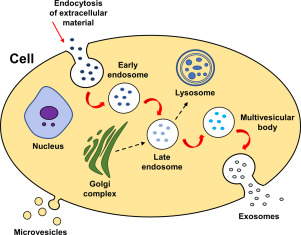当前位置:
X-MOL 学术
›
BBA Mol. Cell Biol. Lipids
›
论文详情
Our official English website, www.x-mol.net, welcomes your
feedback! (Note: you will need to create a separate account there.)
Lipidomic characterization of exosomes isolated from human plasma using various mass spectrometry techniques.
Biochimica et Biophysica Acta (BBA) - Molecular and Cell Biology of Lipids ( IF 3.9 ) Pub Date : 2020-01-21 , DOI: 10.1016/j.bbalip.2020.158634 Ondřej Peterka 1 , Robert Jirásko 1 , Michaela Chocholoušková 1 , Ladislav Kuchař 2 , Denise Wolrab 1 , Roman Hájek 1 , David Vrána 3 , Ondřej Strouhal 3 , Bohuslav Melichar 3 , Michal Holčapek 1
Biochimica et Biophysica Acta (BBA) - Molecular and Cell Biology of Lipids ( IF 3.9 ) Pub Date : 2020-01-21 , DOI: 10.1016/j.bbalip.2020.158634 Ondřej Peterka 1 , Robert Jirásko 1 , Michaela Chocholoušková 1 , Ladislav Kuchař 2 , Denise Wolrab 1 , Roman Hájek 1 , David Vrána 3 , Ondřej Strouhal 3 , Bohuslav Melichar 3 , Michal Holčapek 1
Affiliation

|
Ultrahigh-performance supercritical fluid chromatography - mass spectrometry (UHPSFC/MS), ultrahigh-performance liquid chromatography - mass spectrometry (UHPLC/MS), and matrix-assisted laser desorption/ionization (MALDI) - MS techniques were used for the lipidomic characterization of exosomes isolated from human plasma. The high-throughput methods UHPSFC/MS and UHPLC/MS using a silica-based column containing sub-2 μm particles enabled the lipid class separation and the quantitation based on exogenous class internal standards in <7 minute run time. MALDI provided the complementary information on anionic lipid classes, such as sulfatides. The nontargeted analysis of 12 healthy volunteers was performed, and absolute molar concentration of 244 lipids in exosomes and 191 lipids in plasma belonging to 10 lipid classes were quantified. The statistical evaluation of data included principal component analysis, orthogonal partial least square discriminant analysis, S-plots, p-values, T-values, fold changes, false discovery rate, box plots, and correlation plots, which resulted in the information on lipid changes in exosomes in comparison to plasma. The major changes were detected in the composition of triacylglycerols, diacylglycerols, phosphatidylcholines, and lysophosphatidylcholines, whereby sphingomyelins, phosphatidylinositols, and sulfatides showed rather similar profiles in both biological matrices.
中文翻译:

使用各种质谱技术从人血浆中分离出的外泌体的脂质组学表征。
超高效液相色谱-质谱(UHPSFC / MS),超高效液相色谱-质谱(UHPLC / MS)和基质辅助激光解吸/电离(MALDI)-MS技术用于脂质体表征从人血浆中分离出的外泌体。使用包含亚2μm颗粒的硅胶色谱柱的高通量方法UHPSFC / MS和UHPLC / MS,可在不到7分钟的运行时间内完成脂质类别的分离和基于外源类别内标的定量。MALDI提供了有关阴离子脂质类(如硫化物)的补充信息。进行了12位健康志愿者的非靶向分析,定量了10种脂质类别的外泌体中244种脂质的绝对摩尔浓度和血浆中191种脂质的绝对摩尔浓度。数据的统计评估包括主成分分析,正交偏最小二乘判别分析,S曲线,p值,T值,倍数变化,错误发现率,盒图和相关图,从而获得了有关脂质的信息与血浆相比,外泌体的变化。在三酰基甘油,二酰基甘油,磷脂酰胆碱和溶血磷脂酰胆碱的组成中检测到主要变化,从而鞘磷脂,磷脂酰肌醇和硫酸酯在两种生物基质中显示出相当相似的特征。与血浆相比,这提供了有关外泌体脂质变化的信息。在三酰基甘油,二酰基甘油,磷脂酰胆碱和溶血磷脂酰胆碱的组成中检测到主要变化,从而鞘磷脂,磷脂酰肌醇和硫酸酯在两种生物基质中显示出相当相似的特征。与血浆相比,这提供了有关外泌体脂质变化的信息。在三酰基甘油,二酰基甘油,磷脂酰胆碱和溶血磷脂酰胆碱的组成中检测到主要变化,从而鞘磷脂,磷脂酰肌醇和硫酸酯在两种生物基质中显示出相当相似的特征。
更新日期:2020-01-22
中文翻译:

使用各种质谱技术从人血浆中分离出的外泌体的脂质组学表征。
超高效液相色谱-质谱(UHPSFC / MS),超高效液相色谱-质谱(UHPLC / MS)和基质辅助激光解吸/电离(MALDI)-MS技术用于脂质体表征从人血浆中分离出的外泌体。使用包含亚2μm颗粒的硅胶色谱柱的高通量方法UHPSFC / MS和UHPLC / MS,可在不到7分钟的运行时间内完成脂质类别的分离和基于外源类别内标的定量。MALDI提供了有关阴离子脂质类(如硫化物)的补充信息。进行了12位健康志愿者的非靶向分析,定量了10种脂质类别的外泌体中244种脂质的绝对摩尔浓度和血浆中191种脂质的绝对摩尔浓度。数据的统计评估包括主成分分析,正交偏最小二乘判别分析,S曲线,p值,T值,倍数变化,错误发现率,盒图和相关图,从而获得了有关脂质的信息与血浆相比,外泌体的变化。在三酰基甘油,二酰基甘油,磷脂酰胆碱和溶血磷脂酰胆碱的组成中检测到主要变化,从而鞘磷脂,磷脂酰肌醇和硫酸酯在两种生物基质中显示出相当相似的特征。与血浆相比,这提供了有关外泌体脂质变化的信息。在三酰基甘油,二酰基甘油,磷脂酰胆碱和溶血磷脂酰胆碱的组成中检测到主要变化,从而鞘磷脂,磷脂酰肌醇和硫酸酯在两种生物基质中显示出相当相似的特征。与血浆相比,这提供了有关外泌体脂质变化的信息。在三酰基甘油,二酰基甘油,磷脂酰胆碱和溶血磷脂酰胆碱的组成中检测到主要变化,从而鞘磷脂,磷脂酰肌醇和硫酸酯在两种生物基质中显示出相当相似的特征。











































 京公网安备 11010802027423号
京公网安备 11010802027423号